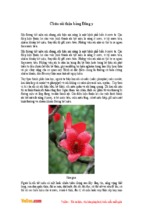Molecular Plant Advance Access published October 8, 2014
Unravelling the Triterpenoid Saponin Biosynthesis of the African Shrub Maesa
lanceolata
Tessa Mosesa,b,c,d,e,2,, Jacob Polliera,b,2, Ahmad Faizalf,g, Sandra Apersh, Luc Pietersh, Johan M.
Theveleinc,d, Danny Geelenf, and Alain Goossensa,b,1
a
b
Department of Plant Biotechnology and Bioinformatics, Ghent University, Technologiepark
927, B-9052 Gent, Belgium
c
Department of Molecular Microbiology, VIB, Kasteelpark Arenberg 31, B-3001 Leuven-
Heverlee, Belgium
d
Laboratory of Molecular Cell Biology, Institute of Botany and Microbiology, KU Leuven,
Kasteelpark Arenberg 31, B-3001 Leuven-Heverlee, Belgium
e
Present address: John Innes Centre, Norwich Research Park, Colney Lane, Norwich NR4
7UH, United Kingdom
f
Department of Plant Production, Faculty of Bioscience Engineering, Ghent University,
Coupure Links 653, 9000 Ghent, Belgium
g
Present address: School of Life Sciences & Technology, Institut Teknologi Bandung, Jl.
Ganesa No. 10 Bandung, Indonesia 40132
h
Laboratory of Pharmacognosy and Pharmaceutical Analysis, Department of Pharmaceutical
Sciences, University of Antwerp, Universiteitsplein 1, B-2610 Antwerp, Belgium
1
To whom correspondence should be addressed. E-mail
[email protected], tel. +32
93313851, fax +32 93313809.
2
These authors contributed equally to this work.
Running title: Maesa lanceolata triterpenoid saponin biosynthesis
Short Summary: Maesasaponins produced by the African shrub Maesa lanceolata are
oleanane-type saponins with diverse biological activities. Through transcript profiling of
methyl jasmonate elicited M. lanceolata shoot cultures followed by functional analysis in
transgenic M. lanceolata plants and the heterologous hosts Medicago truncatula and
1
Downloaded from http://mplant.oxfordjournals.org/ at University of North Carolina at Chapel Hill on November 6, 2014
Department of Plant Systems Biology, VIB, Technologiepark 927, B-9052 Gent, Belgium
Saccharomyces cerevisiae, we identified three maesaponin biosynthesis genes. These include
a β-amyrin synthase and two cytochrome P450s, CYP716A75 and CYP87D16, which
catalyse the C-28 oxidation and C-16α of β-amyrin, respectively.
Downloaded from http://mplant.oxfordjournals.org/ at University of North Carolina at Chapel Hill on November 6, 2014
2
ABSTRACT
Maesasaponins produced by the African shrub Maesa lanceolata are
oleanane-type saponins with diverse biological activities. Candidate maesasaponin
biosynthesis genes were identified through transcript profiling of M. lanceolata shoot
cultures treated with methyl jasmonate, a well-known elicitor of plant specialized
metabolism. Heterologous expression of the identified genes in Saccharomyces cerevisiae
led to the identification of one oxidosqualene cyclase (MlbAS) and two cytochrome
P450s, CYP716A75 and CYP87D16, which catalyse three enzymatic steps of
oxidosqualene to β-amyrin in yeast, and its role in maesasaponin biosynthesis was
confirmed by gain- and loss-of-gene-function experiments in transgenic M. lanceolata
plants. When expressed in β-amyrin-producing yeast, CYP716A75 catalyses the C-28
oxidation of β-amyrin, leading to the accumulation of mainly erythrodiol. Accordingly,
expression of CYP716A75 in a Medicago truncatula mutant lacking C-28 oxidase activity
partially complemented the mutant phenotype. CYP87D16 catalyses the C-16α oxidation
of β-amyrin in yeast, leading to the accumulation of 16α-hydroxy β-amyrin. This activity
was hitherto only linked to a CYP716-type P450 from a distinct plant species, thereby
suggesting that C-16α oxidase activity has evolved independently in different plant
lineages. The identified biosynthesis genes will be useful for synthetic biology programs
toward the production of bioactive triterpenoids.
Key words: Cytochrome P450; oxidosqualene cyclase; C-28 oxidase; C-16α oxidase;
CYP716; CYP87; triterpenoid saponin; Maesa lanceolata.
3
Downloaded from http://mplant.oxfordjournals.org/ at University of North Carolina at Chapel Hill on November 6, 2014
maesasaponin biosynthesis. MlbAS is a β-amyrin synthase that converts 2,3-
INTRODUCTION
Triterpenoid saponins are a large class of structurally diverse and biologically active
specialized metabolites produced by numerous plant species. They are amphipathic glycosides
consisting of a hydrophobic backbone or sapogenin with one or more hydrophilic sugar chains
attached to it. Triterpenoid saponins display a wide range of commercial applications in the
agricultural, food, cosmetic and pharmaceutical sectors as pesticides, preservatives,
surfactants, adjuvants, antimicrobial, anti-inflammatory and anticancer agents (Augustin et
Nonetheless, their applications are still limited, mainly because they occur as complex
product mixtures from which isolation of a pure compound is challenging or because of the
low in planta production level for many of them. One way of overcoming the latter limitation
is through the engineering of plants, cell cultures and/or microorganisms to obtain an
increased production rate (Moses et al., 2013). A thorough understanding of the biosynthetic
pathways and regulatory mechanisms involved in target compound synthesis in the native
host is a prerequisite for engineering organisms for enhanced production. However, for most
triterpenoid saponins, such comprehensive information is currently lacking.
Like sterols, the triterpenoid saponins are biosynthesized from isopentenyl
pyrophosphate (IPP) generated via the 3-hydroxy-3-methylglutaryl CoA reductase (HMGR)dependent mevalonate (MVA) pathway. The head-to-tail fusion of two C5 IPP units with one
C5 dimethylallyl pyrophosphate (DMAPP) unit results in the formation of C15 farnesyl
pyrophosphate (FPP); two of which condense head-to-head to form C30 squalene, the
precursor of all triterpenoids in eukaryotes. The linear squalene is subsequently epoxidized to
2,3-oxidosqualene, the last common intermediate in triterpenoid saponin and sterol
biosynthesis. The two pathways diverge after 2,3-oxidosqualene, which is cyclized by specific
oxidosqualene cyclases (OSCs) to either cycloartenol, the plant sterol precursor, or to a wide
variety of specific triterpenoid backbones. In nature, over 100 distinct triterpenoid skeletons
have been identified, the most common ones being β-amyrin (oleanane), α-amyrin (ursane),
lupeol (lupane) and dammarenediol (dammarane) (Xu et al., 2004; Xue et al., 2012). After
cyclization, the triterpenoids are decorated by multiple cytochrome P450-dependent
monooxygenases (P450s) to generate a diverse array of sapogenins containing reactive
functional groups. To date, 22 triterpenoid-modifying P450s that catalyse different reactions
on 16 different carbon positions have been reported from different plant species (Han et al.,
2013; Moses et al., 2014b; Thimmappa et al., 2014). Ultimately, the sapogenins are
4
Downloaded from http://mplant.oxfordjournals.org/ at University of North Carolina at Chapel Hill on November 6, 2014
al., 2011; Osbourn et al., 2011; Pollier et al., 2011c; Sparg et al., 2004; Vincken et al., 2007).
glycosylated by UDP-dependent glycosyltransferases (UGTs) and may be further decorated
by other ‘tailoring’ enzymes, like acetyltransferases and malonyltransferases, to generate the
biologically active saponins (Osbourn et al., 2011; Thimmappa et al., 2014).
In plants, saponins serve as defence molecules and their production is often triggered
by biotic and abiotic stress. The concerted transcriptional response of the entire saponin
biosynthetic pathway to different stresses is controlled by a complex signalling cascade in
which the jasmonate hormones play a crucial role (De Geyter et al., 2012; Pauwels et al.,
transcriptional activation of saponin biosynthetic genes, and transcript profiling of jasmonateelicited plants or cell cultures can be used as a tool for identifying candidate saponin
biosynthesis genes. The identified candidates can consequently be expressed in heterologous
systems for functional characterization. Likewise, loss of function of a biosynthetic enzyme
can lead to the lack of accumulation of the resulting saponins. For instance, loss of function of
CYP716A12, the Medicago truncatula P450 that catalyses the three-step oxidation of βamyrin to oleanolic acid, blocks the synthesis of haemolytic saponins in the mutant called
lacking haemolytic activity (lha) (Carelli et al., 2011). Therefore, a second way of
characterizing gene function is by using gene knock-down and knock-out strategies for
candidate biosynthesis genes in the native plant host, followed by analysis of the saponin
spectrum.
Maesa lanceolata, a member of the Myrsinaceae family, is a shrub or small tree
indigenous to East, South and Central Africa. African traditional healers use parts and extracts
of the plant for the treatment of a wide range of diseases, including infectious hepatitis,
bacillary dysentery, impetigo, ozena, dermatoses and neuropathies. Methanol extracts of
M. lanceolata leaves are rich in triterpenoid saponins, called maesasaponins, which have been
shown to possess virucidal, molluscicidal, fungistatic and antimutagenic activities
(Sindambiwe et al., 1998). The maesasaponins identified from M. lanceolata are of the
oleanane-type, derived from multiple modifications of the β-amyrin backbone. Many contain
characteristic C-13,28 hemiacetal or ester bridges, and display oxidations on the C-16, C-21
and/or C-22 positions (Figure 1A and 1B) (Foubert et al., 2010; Manguro et al., 2011). The
hemiacetal and ester bridges are thought to result from the reaction between a C-13 hydroxyl
and C-28 aldehyde or carboxyl group, respectively (Vincken et al., 2007). The occurrence of
these diverse saponins in M. lanceolata implies the presence of OSCs and P450s in the plant
that cyclize 2,3-oxidosqualene to β-amyrin, which is further oxidized at its C-13, C-16, C-21,
C-22 and/or C-28 positions.
5
Downloaded from http://mplant.oxfordjournals.org/ at University of North Carolina at Chapel Hill on November 6, 2014
2009). As such, treatment of whole plants or plant cell cultures with jasmonates leads to the
Several β-amyrin synthases (bASs) have been functionally characterized using
Saccharomyces cerevisiae, including bAS from Artemisia annua (Kirby et al., 2008),
Medicago truncatula (Suzuki et al., 2002), Glycyrrhiza glabra (Hayashi et al., 2001) and
Saponaria vaccaria (Meesapyodsuk et al., 2007). Similarly, P450s catalysing C-28 oxidations
(Carelli et al., 2011; Fukushima et al., 2011; Han et al., 2013; Huang et al., 2012), C-16α
hydroxylation (Moses et al., 2014b), C-12,13β-epoxidation together with C-16β
hydroxylation (Geisler et al., 2013; Kunii et al., 2012) and C-22 hydroxylation (Seki et al.,
In this study, we performed cDNA-amplified fragment length polymorphism (cDNAAFLP)-based transcript profiling on methyl jasmonate (MeJA)-treated M. lanceolata shoot
cultures to identify candidate maesasaponin biosynthesis genes. The functional activity of the
candidate genes was screened for by heterologous expression in a sterol engineered
S. cerevisiae strain. This led to the identification of one OSC that was characterized as a bAS
of which the role in maesasaponin biosynthesis was confirmed by overexpression and
silencing strategies in transgenic M. lanceolata plants. Furthermore, we identified two P450s
that, together with the characterized bAS, catalyse three enzymatic steps involved in
maesasaponin biosynthesis (Figure 1C).
RESULTS
Transcript Profiling of M. lanceolata Shoots Reveals Candidate Saponin Biosynthesis
Genes
Jasmonate inducibility of maesasaponin production in M. lanceolata has not been reported
yet. Maesasaponins are produced in the leaves of M. lanceolata plants from indigenous
collection sites. To assess MeJA inducibility of maesasaponin synthesis, M. lanceolata axenic
shoot cultures were generated from this material, cultivated in liquid cultures and elicited with
MeJA. No unambiguous effect of MeJA (or any other phytohormone) on maesasaponin
accumulation in these explants could be observed but the addition of MeJA (but none of the
other phytohormones) led to excessive foaming, which might be indicative of either MeJA
induced secretion or increased production of maesasaponins (Faizal, 2013). Considering this,
and taking into account the conserved transcriptional response of entire saponin biosynthetic
pathways across the plant kingdom to the jasmonate hormone (De Geyter et al., 2012), we
therefore carried out transcriptome analysis of MeJA-elicited M. lanceolata explants.
6
Downloaded from http://mplant.oxfordjournals.org/ at University of North Carolina at Chapel Hill on November 6, 2014
2011) of triterpenoid backbones have been characterized using yeast strains.
cDNA-AFLP-based transcript profiling was performed on a time-course sample set of
MeJA-treated M. lanceolata axenic shoot cultures. The expression of 13,558 transcript tags
was monitored, and 733 MeJA-responsive tags were isolated (hereafter called ML tags), reamplified and sequenced. Good quality sequences were obtained for 545 (74.4%) ML tags; to
the remaining 188 (25.6%) tags no unique sequence could be attributed unambiguously. Of
the 545 unique ML tags, 312 (57.2%) were tentatively annotated following BLAST analysis.
An average linkage hierarchical clustering analysis showed that after MeJA treatment, the
or repressed (Cluster VI, Supplemental Figure 1). Based on their MeJA response time, the
induced gene tags were divided into five subclusters. Genes in Cluster V responded within 2 h
of MeJA treatment, whereas genes in Cluster IV reached maximum expression 4-8 h after
MeJA treatment. Cluster II consists of genes that were induced 2 h after MeJA treatment,
maintaining a high expression level thereafter. In Clusters I and III, genes were activated 24 h
after MeJA treatment.
ML tags corresponding to enzymes known to be involved in triterpenoid biosynthesis,
like acetoacetyl-CoA thiolase (AACT), HMGR, and squalene epoxidase (SQE), belong to
Cluster III and were transcriptionally activated 24 h post MeJA elicitation (Figure 2A). No tag
corresponding to bAS, the first committed enzyme for saponin biosynthesis in M. lanceolata,
was encountered in our transcript profiling analysis, whereas 16 ML tags corresponded to
P450s, which represent the second set of enzymes involved in saponin biosynthesis. Of these
16 ML tags, three (ML449, ML265 and ML177) were transcriptionally repressed after MeJA
treatment and were therefore not considered as candidates for saponin biosynthesis. For 8 of
the remaining 13 tags, full-length (FL) coding sequences were obtained using an integrated
PCR-colony hybridization approach (Pollier et al., 2011a). Two tags (ML041 and ML104)
with a nearly identical expression pattern corresponded to the same gene, and hence, seven
candidate P450s were retained, all of which were transcriptionally activated within 24 h of
MeJA treatment (Figure 2A). The obtained sequences were submitted to GenBank and the
P450 naming committee and an overview of the names and accession numbers is given in
Supplemental Table 1.
Identification and Characterization of MlbAS, the First Committed Enzyme for
Maesasaponin Biosynthesis
7
Downloaded from http://mplant.oxfordjournals.org/ at University of North Carolina at Chapel Hill on November 6, 2014
selected ML tags were either transcriptionally induced (Clusters I-V, Supplemental Figure 1)
As no ML tag corresponding to bAS was encountered in the cDNA-AFLP transcript profiling
analysis, we designed degenerate oligonucleotide primers based on characterized bAS genes
from different plants, and amplified a gene tag corresponding to bAS using a M. lanceolata
cDNA template. The sequence thus obtained was used to screen for the FL open reading
frame of the M. lanceolata β-amyrin synthase (MlbAS) in a cDNA library (Pollier et al.,
2011a). The FL MlbAS encodes a 760 amino acid-long protein with conserved SDCTAE and
MWCYCR motifs, which are essential for substrate binding and β-amyrin product specificity,
polycyclization reaction, and a key conserved Lys residue at position 449, which is conserved
in all specific bASs (Supplemental Figure 2) (Kushiro et al., 2000; Poralla, 1994).
To check its functionality, we heterologously expressed the FL MlbAS gene in the
sterol engineered yeast strain TM1 (Supplemental Table 2) (Moses et al., 2014b). Using gas
chromatography – mass spectrometry (GC-MS) analysis, organic extracts of cultures of the
yeast strain TM4 harbouring the plasmid pESC-URA[GAL10/tHMG1; GAL1/MlbAS] and the
control strain TM5 harbouring the plasmid pESC-URA[GAL10/tHMG1] were compared. A
single, low-abundant peak at 27.2 min was observed to be unique to the GC chromatogram of
TM4 (Figure 2B). Its corresponding electron ionization – mass spectrometry (EI-MS) pattern
was similar to that of a β-amyrin standard, but consisted of only the most abundant m/z
fragment ions 189, 203 and 218. A clear β-amyrin peak was observed in TM4 with select ion
monitoring of m/z ions 203 and 218 (inset, Figure 2B). Although β-amyrin was detected in the
yeast strain TM4, the 2,3-oxidosqualene cyclization efficiency of MlbAS in yeast was
observed to be very low.
MlbAS Overexpression Leads to Growth and Developmental Defects in M. lanceolata
Plants
To confirm the functionality of the identified MlbAS and its role in maesasaponin
biosynthesis, we analysed the effect of MlbAS overexpression and silencing in planta.
Transgenic M. lanceolata plants constitutively expressing a hairpin RNA-mediated
interference (hpRNAi) construct against MlbAS were generated by Agrobacterium
tumefaciens-mediated transformation, and transcript levels were determined by RT-PCR. The
maesasaponin accumulation in independent hpRNAi lines, with varying degrees of MlbAS
8
Downloaded from http://mplant.oxfordjournals.org/ at University of North Carolina at Chapel Hill on November 6, 2014
respectively. In addition, the MlbAS contains six QW repeats, which are imperative for the
suppression, was determined by qualitative thin layer chromatography (TLC) analysis. We
observed a clear correlation between reduced transcript levels and reduced maesasaponin
accumulation in planta (Figure 2C), suggesting that MlbAS is indeed a key player involved in
the biosynthesis of maesasaponins.
In addition to gene suppression, we also analysed the effect of MlbAS overexpression
on the accumulation of maesasaponins in transgenic M. lanceolata plants. Analysis of
transcript levels by RT-PCR revealed that MlbAS overexpression resulted in either higher or
transgenic plants, the accumulation of maesasaponins correlated with the elevated or reduced
MlbAS transcript levels (Figure 2D). Furthermore, the M. lanceolata plants with elevated
MlbAS transcript levels showed growth and morphological defects when grown under
greenhouse conditions. When compared to a control plant, the MlbAS overexpressing plants
exhibited a dwarf phenotype with small yellowish leaves (Figure 2E), presumably resulting
from the altered in planta flux balances among triterpenoid derived sterol, hormone,
chlorophyll and/or saponin biosynthesis. Similar phenotypic effects have been reported for
several other plants where saponin biosynthesis was altered in planta to result in the
accumulation of biosynthetic saponin intermediates which do not normally accumulate in the
plant, suggesting a role for the saponins and their intermediates in plant growth and
development processes (Moses et al., 2014a).
To correlate the phenotypic effects with saponins and/or saponin biosynthetic
intermediates, we first assessed the accumulation of β-amyrin using GC-MS in control plants
and the MlbAS overexpressing plant O5, which has the most severely altered growth and
development phenotype. Notably, β-amyrin levels were lower in the leaves of O5 lines when
compared to control lines (Figure 2F). Since the M. lanceolata transgenic lines have
functional downstream enzymes for the subsequent modification of β-amyrin to
maesasaponins, we reasoned that the decreased accumulation of β-amyrin in the O5 line could
be a result of its further modification in planta, which would then result in altered
accumulation of maesasapogenins and/or maesasaponins, as suggested by the TLC analysis
(Figure 2D). To further assess this, we screened the GC chromatograms of O5 lines for the
accumulation of potential maesasaponin intermediates erythrodiol, oleanolic acid and
echinocystic acid, and performed liquid chromatography – mass spectrometry (LC-MS)
analysis on the control and O5 lines to determine levels of maesasaponins in these lines. None
of the screened maesasapogenins could be detected in the GC chromatograms, but higher
accumulation of maesasaponins could indeed be observed in the O5 lines (Figure 2G). The
9
Downloaded from http://mplant.oxfordjournals.org/ at University of North Carolina at Chapel Hill on November 6, 2014
lower gene expression, the latter presumably resulting from co-suppression. Also in these
higher accumulation of maesasaponins in O5 lines suggests an increased flux through the
pathway resulting from the overexpression of MlbAS and links the phenotypic effects to either
the decreased accumulation of β-amyrin, or the increased accumulation of maesasaponins.
Yeast-Based In Vivo Screening of Candidate P450s Identifies Two Functional Enzymes
To identify functional enzymes capable of modifying the oleanane triterpenoid β-amyrin, we
P450 reductase (AtATR1), from the β-amyrin producing strain TM3 expressing the bAS gene
from Glycyrrhiza glabra (Moses et al., 2014b), since the MlbAS expressing strain TM4
showed only very low accumulation of β-amyrin. Cell extracts of 72-h-old cultures of these
seven yeast strains were compared to a control strain by GC-MS analysis. The GC
chromatograms of two candidate P450s, i.e. CYP716A75 (tag ML257) and CYP87D16 (tag
ML593), showed unique peaks that did not occur in the control strain, suggesting a functional
activity in the modification of β-amyrin in vivo (Figure 3A).
The P450s CYP716A75 and CYP87D16 represent 487 and 475 amino acid-long
proteins, respectively. A phylogenetic analysis with all the functionally characterized
triterpenoid-modifying P450s clearly grouped CYP716A75 with the functionally diverse
CYP716A family, whereas CYP87D16 did not group with any particular P450 family
(Figure 3B, Supplemental Figure 3).
CYP716A75 Is a C-28 Oxidase
To identify the enzymatic activity of CYP716A75, yeast strain TM20, heterologously
producing the protein, was cultured in the presence of methyl-β-cyclodextrin (MβCD) to
sequester triterpenoids from yeast cells to the growth medium (Moses et al., 2014b). The GC
chromatogram of the organic extract obtained from its spent culture medium was compared to
that of the control strain TM27, not expressing a P450. Three peaks were unique to strain
TM20, and two of these matched authentic standards of erythrodiol and oleanolic acid. From
the EI-MS pattern, the third peak was deduced to be oleanolic aldehyde, but its identity could
not be confirmed due to the lack of an authentic standard (Figure 4A and 4B). A semiquantitation of the peak intensities revealed the accumulation of erythrodiol : oleanolic
aldehyde : oleanolic acid to be in the ratio 8.7 : 1.1 : 0.2. This observation suggests a higher
efficiency of CYP716A75 to catalyse the first oxidation from β-amyrin to erythrodiol, and a
10
Downloaded from http://mplant.oxfordjournals.org/ at University of North Carolina at Chapel Hill on November 6, 2014
generated seven yeast strains, heterologously expressing a candidate P450 and the A. thaliana
considerably lower efficiency to continue the consequent oxidations to oleanolic acid via
oleanolic aldehyde, when heterologously expressed in yeast. Furthermore, the products
formed by CYP716A75 were identical to those detected in strain TM17 (Figure 4A),
expressing CYP716A12, the M. truncatula P450 that catalyses the three-step oxidation of βamyrin to oleanolic acid (Carelli et al., 2011). CYP716A12 displays an erythrodiol : oleanolic
aldehyde : oleanolic acid product ratio of 6.5 : 2.4 : 1.1, further underscoring the relatively
low efficiency of CYP716A75 to continue the consequent oxidations to oleanolic acid in
(Figure 4C). Additionally, in the phylogenetic analysis, CYP716A75 clustered together with
the other CYP716A subfamily C-28 oxidases that have been characterized to be involved in
saponin biosynthesis (Figure 3B).
CYP716A75 Complements the M. truncatula lha-1 Mutant
Since CYP716A75 from M. lanceolata is a functional C-28 oxidase, we determined its ability
to functionally complement the lha-1 mutant, a cyp716a12 mutant of M. truncatula which
lacks the C-28 oxidase activity and therefore does not accumulate oleanolic acid derived
haemolytic saponins (Carelli et al., 2011). We generated five different types of transgenic
M. truncatula hairy roots for this complementation assay. Three types of hairy roots were
generated from the loss-of-function lha-1 mutant line expressing the M. lanceolata
CYP716A75, a functional copy of the M. truncatula CYP716A12, or a control GUS construct.
Two additional types of control hairy roots were generated by expressing the control GUS
construct in hairy roots derived from the E25-08 wild-type background and the E113 escape
line (Carelli et al., 2011). The saponin compositions of the transgenic hairy roots were
analysed by LC-MS. Similar to lha-1 mutant plants and contrary to hairy roots derived from
the E25-08 and E113 control lines, the lha-1 control hairy roots did not accumulate
haemolytic saponins, whereas the accumulation of non-haemolytic soyasaponins was
comparable between hairy roots derived from the three M. truncatula backgrounds. The
expression of a functional copy of the M. truncatula CYP716A12 in hairy roots derived from
the lha-1 mutant restored the C-28 oxidase activity in the mutant and resumed the
accumulation of haemolytic saponins, confirming the utility of this screening approach
(Figure 5A). It should be noted however, that most, if not all, accumulating haemolytic
saponins were less abundant in the CYP716A12-expressing lha-1 hairy roots as compared to
hairy roots derived from the E25-08 and E113 control lines (Figure 5B-5D). Analysis of the
11
Downloaded from http://mplant.oxfordjournals.org/ at University of North Carolina at Chapel Hill on November 6, 2014
yeast. Nonetheless, overall, our data confirm the C-28 oxidase activity of CYP716A75
LC chromatograms of the lha-1 hairy roots heterologously expressing the M. lanceolata
CYP716A75 also showed the accumulation of haemolytic saponins, confirming restored C-28
oxidase activity and hence complementation of the loss of function of the native CYP716A12
in M. truncatula (Figure 5A). However, when compared to lha-1 hairy roots expressing
CYP716A12, the lha-1 hairy roots expressing CYP716A75 accumulated even lower levels of
the haemolytic saponins (Figure 5B-E), indicating lower C-28 carboxylation activity of
M. lanceolata CYP716A75 as compared to M. truncatula CYP716A12. Alternatively,
the resulting protein cannot be ruled out as possible experimental factors contributing to the
lower accumulation.
In addition to lower levels of natural Medicago saponins, lha-1 hairy roots expressing
CYP716A75 accumulated high levels of certain saponins, which were nearly absent in lha-1
hairy roots expressing CYP716A12 or in hairy roots derived from the E25-08 and E113
control lines (Figure 5C). Based on the accurate masses and the generated MSn spectra, these
compounds were tentatively identified as saponins with aglycones having incomplete
oxidation (alcohol or aldehyde) at position C-28 (Supplemental Figure 4).
CYP87D16 Is a C-16α Oxidase
To functionally characterize CYP87D16, yeast strain TM21, harbouring the plasmids
pAG415[GAL1/AtATR1] and pAG423[GAL1/CYP87D16] in the parent strain TM3, and the
control strain TM27, were cultured in the presence of MβCD. Organic extracts of the spent
medium obtained from the strains were then analysed by GC-MS, revealing a unique peak in
the GC chromatogram of strain TM21 (Figure 6A). The parent ion at m/z 586 in the EI-MS
pattern of this peak suggested the presence of an extra hydroxyl group on β-amyrin
(Figure 6B). Furthermore, the fragment ions at m/z 201, 216 and 306 resulting from a retroDiels-Alder fragmentation of the oleanane backbone, indicated that the additional hydroxyl
group was located either on the D or E ring of β-amyrin. The retention time and EI-MS
pattern of this peak were identical to those of 16α-hydroxy β-amyrin (Figure 6C and 6D),
which was produced in strain TM9 as a result of the hydroxylation of β-amyrin by
CYP716Y1, a P450 we previously characterized (Moses et al., 2014b). Therefore, it could be
concluded that the M. lanceolata CYP87D16 encodes a C-16α oxidase involved in
maesasaponin biosynthesis.
12
Downloaded from http://mplant.oxfordjournals.org/ at University of North Carolina at Chapel Hill on November 6, 2014
variation in transgene copy number, level of transcript expression, and folding and stability of
Combined Expression of CYP87D16 and CYP716A75 in Yeast
To generate intermediates of the maesasaponin biosynthesis pathway in yeast, we generated
yeast strain TM104 from the parent strain TM3. Next to the A. thaliana P450 reductase
(AtATR1), yeast strain TM104 expresses both CYP87D16 and CYP716A75 from a single
high-copy number plasmid to produce a self-processing polyprotein in which the two P450s
are linked via a 2A oligopeptide (de Felipe et al., 2006). Comparison of GC chromatograms
of organic extracts obtained from the culture medium of this strain, with those of strains
(Figure 7A). The retention time and EI-MS pattern of the second peak (co-migrating with
another peak present in all extracts) matched those of an authentic echinocystic acid standard
(Figure 7B), confirming the C-16α oxidation by CYP87D16 and the C-28 oxidation by
CYP716A75. For the first and the third unique peaks, no authentic standards were available.
However, based on the enzymatic activities of the expressed P450s, it is expected that these
peaks correspond to 16α-hydroxy erythrodiol and 16α-hydroxy oleanolic aldehyde.
Interpretation of the EI-MS fragmentation patterns of these peaks (Figure 7C) corroborated
this hypothesis. The parent ion at m/z 675 in the EI-MS pattern of the first unique peak in the
organic extract of strain TM104 corresponds with the presence of three hydroxyl groups on
the β-amyrin backbone, as is the case for 16α-hydroxy erythrodiol; whereas the parent ion at
m/z 601 in the EI-MS pattern of the third unique peak would be the expected mass for 16αhydroxy oleanolic aldehyde. In addition, the most abundant fragment ions in both peaks
corresponding to the loss of trimethylsilylated moieties and resulting from retro-Diels-Alder
cleavage of ring C in the backbones (Figure 7C), are in agreement with the expected
fragments of 16α-hydroxy erythrodiol and 16α-hydroxy oleanolic aldehyde. Hence, the
combined expression of CYP87D16 and CYP716A75 in yeast leads to the accumulation of
three intermediates involved in maesasaponin biosynthesis. The first, 16α-hydroxy
erythrodiol, is a precursor of maesasaponins without C-13,28 bridge, whereas 16α-hydroxy
oleanolic aldehyde and echinocystic acid are precursors of maesasaponins with a hemiacetal
or ester bridge, respectively (Figure 1C).
DISCUSSION
Despite the broad applications of triterpenoid saponins, their industrial utilization is limited by
the low availability of pure compounds from plant sources for pharmaceutical and cosmetic
13
Downloaded from http://mplant.oxfordjournals.org/ at University of North Carolina at Chapel Hill on November 6, 2014
TM20 and TM21 revealed the presence of three peaks that are unique to strain TM104
applications and the restricted knowledge of their biosynthetic pathways, which prevents
generation of heterologous production systems. Maesasaponins constitute a wide spectrum of
structurally unique triterpenoids with promising pharmaceutical activities, but no
corresponding biosynthesis genes had been identified. In this study, we characterized three
enzymes involved in the synthesis of maesasaponins, which are inherent to the African shrub
M. lanceolata.
The MlbAS gene was cloned through a degenerate PCR approach and functionally
characterized using our sterol modified S. cerevisiae strain TM1. However, very low βamyrin accumulation was observed in the resulting yeast, indicating poor exogenous activity
of MlbAS in this heterologous host. Previously, we reported accumulation of 36 mg/L and
19 mg/L β-amyrin in strains derived from TM1 when the bAS gene from G. glabra and M.
truncatula bAS, respectively, were expressed (Moses et al., 2014b), suggesting differences in
the functional activities of bAS enzymes obtained from different plants. These differences in
enzyme activities could be attributed to several factors including the lack of upstream
elements for the optimal expression of plant genes in yeast, non-optimized codon usage,
protein mislocalization, protein misfolding and/or protein instability. Nonetheless, the
overexpression of MlbAS in M. lanceolata resulted in increased accumulation of
maesasaponins and its silencing or co-suppression resulted in decreased maesasaponin levels
in the transgenic plants, suggesting that this gene indeed codes for a functional enzyme, and
plays an important role in planta for the production of maesaponins.
Functional Characterisation of CYP87D16 Suggests Independent Evolvement of 16α
Oxidase Activity in the Plant Kingdom
Plant P450s are conventionally classified into two main classes, the A-type and non-A-type.
The A-type P450s belong to a single clade and are involved in the synthesis of plant-specific
specialized metabolites, spanning alkaloids, terpenoids, and phenolics, whereas the non-Atype P450s are distributed over six clades representing enzymes involved in metabolic
housekeeping functions, like the synthesis of sterols, fatty acids, hormones and other
signalling molecules (Schuler and Werck-Reichhart, 2003). The CYP87 family belongs to the
non-A-type multi-family CYP85 clan of which the majority is involved in hormone
metabolism (Bak et al., 2011). During evolution, the CYP87 family first appeared in
14
Downloaded from http://mplant.oxfordjournals.org/ at University of North Carolina at Chapel Hill on November 6, 2014
Functional Activity of MlbAS in S. cerevisiae and M. lanceolata
monocots, but it is also present in many dicots, including Ericales, the order to which the large
family of Myrsinaceae belongs. The CYP87 family shares a common ancestor with two other
P450 families belonging to the CYP85 clan, namely CYP702 and CYP708, both of which are
involved in triterpenoid biosynthesis (Nelson and Werck-Reichhart, 2011). Extensive P450
phylogenetic analyses have shown no indication of gene duplication in the CYP87 family,
suggesting their involvement in an essential cellular function. Over 40 CYP87 family genes
and pseudogenes belonging to the A, B, C and D subfamilies have been identified in various
M. truncatula, Populus trichocarpa (poplar), Vitis vinifera (grape) and Carica papaya
(papaya) (Guttikonda et al., 2010; Nelson et al., 2008). Of these however, only one,
CYP87A3, has been partially characterized to be implicated in auxin responsiveness of rice
coleoptiles (Chaban et al., 2003).
We functionally characterized CYP87D16 from M. lanceolata, and contrary to the
general assumption that the CYP85 clan members are involved in hormone biosynthesis, it
catalyses the C-16α oxidation of oleanane-type triterpenoid backbones during triterpenoid
saponin biosynthesis. In the field of saponin biosynthesis, another P450, CYP716Y1 from
Bupleurum falcatum (order Apiales), was recently characterized to have C-16α oxidase
activity as well (Moses et al., 2014b). This enzyme belongs to the CYP716 family which
evolved with terrestrial plants and is, like the CYP87 family, a member of the CYP85 clan
(Bak et al., 2011). All members of the CYP716 family identified to date are involved in
triterpenoid saponin metabolism with a total of nine characterized enzymes, all of which
catalyse various oxidations on different carbon positions of the oleanane, ursane, lupane and
dammarane-type triterpenoid backbones. This list also includes M. lanceolata CYP716A75,
which we identified here as a C-28 oxidase, which is identical to the reported activity of its
close homologs from other plant species such as C. roseus, M. truncatula, P. ginseng, and
V. vinifera (Carelli et al., 2011; Fukushima et al., 2011; Han et al., 2013; Huang et al., 2012).
New P450s are named based on amino acid sequence identities, with members of a
family and subfamily sharing ≥ 40% and ≥ 55% identity, respectively (Nelson et al., 2008).
The CYP87D16 protein shows 27% homology to the CYP716Y1 protein, and therefore
belongs to a different P450 family, although they are functional homologs of each other. To
the best of our knowledge, no other examples of P450s from two different gene families
exhibiting the same biochemical function have been reported before. Previous phylogenetic
analyses have not indicated the presence of common ancestry between the CYP87 and
CYP716 families. Our current findings however, suggest a possible, yet unexplored
15
Downloaded from http://mplant.oxfordjournals.org/ at University of North Carolina at Chapel Hill on November 6, 2014
plants including Arabidopsis thaliana, Oryza sativa (rice), Glycine max (soybean),
evolutionary branching within the CYP85 clan of land plants and suggest that C-16α oxidase
activity could have evolved independently and distinctly in different plant species or lineages.
Functionality of Other Candidate P450s
Through heterologous gene expression in yeast, we show the functional activity of two out of
the seven candidate P450s identified through our cDNA-AFLP analysis. Despite the lack of
activity on the β-amyrin backbone, the remaining five candidate P450s might be capable of
CYP716A75. Recent combinatorial synthesis efforts in yeast have demonstrated that some
P450s demonstrate sequential oxidation specificity, and can accept and oxidize only the
reaction products of other P450s. For instance, CYP72A61v2 and CYP72A68v2 from
M. truncatula do not oxidize β-amyrin, but catalyse the C-22 and C-23 oxidations of 24hydroxy β-amyrin and oleanolic acid to generate soyasapogenol B and gypsogenic acid,
respectively (Fukushima et al., 2013). Hence, it would be of interest to determine the possible
functionality of the other candidate P450s in combination with CYP87D16 and CYP716A75,
in particular due to the similar expression profiles of these gene tags after MeJA elicitation in
M. lanceolata shoot cultures. The African shrub M. lanceolata accumulates saponins
containing characteristic C-13,28 bridges, like the Asian plant B. falcatum, although the
bridges occurring in saikosaponins are predominantly of the ether-type, in contrast to the
hemiacetal and ester bridges that occur in maesasaponins (Vincken et al., 2007). Perhaps
some of these P450s may open the synthetic biology gate to these bridges.
METHODS
Chemicals
β-amyrin, erythrodiol, oleanolic acid and echinocystic acid were purchased from
Extrasynthese. Hexane, pyridine and N-methyl-N-(trimethylsilyl)trifluoroacetamide were
purchased from Sigma-Aldrich. Methyl-β-cyclodextrin was purchased from CAVASOL.
Cultivation and Elicitation of M. lanceolata Plants
M. lanceolata axenic shoot cultures were generated and maintained as described previously
(Faizal et al., 2011). For elicitation, each pot of shoot cultures was sprayed with 2 mL
16
Downloaded from http://mplant.oxfordjournals.org/ at University of North Carolina at Chapel Hill on November 6, 2014
modifying intermediates generated as a result of the catalytic action of CYP87D16 and/or
deionized water containing 0.05% (v/v) Tween-20 in combination with 500 μM MeJA
(dissolved in ethanol) or an equivalent amount of ethanol as control. For transcript profiling,
samples were collected 0, 0.5, 1, 2, 4, 8, 24 and 48 h after elicitor or mock treatments. For
each sample, three different plants from three different pots were pooled.
Transcript Profiling
BstYI+1/MseI+2 primer combinations as described (Vuylsteke et al., 2007). For accurate
quantification of band intensities, the gel images were analysed with the AFLP-Quantar Pro
software (KeyGene). The obtained raw expression data were processed and differentially
expressed gene tags were selected for further analysis as described (Moses et al., 2014b).
Cluster analysis, sequencing and BLAST analysis were performed according to Rischer et al.
(2006).
Phylogenetic Analysis and Alignment of bAS Sequences
The protein sequences were retrieved from GenBank and aligned with ClustalW. The
phylogenetic tree was generated with MEGA 5.10 software (Tamura et al., 2011), according
to the Neighbor-Joining method and bootstrapping with 1,000 replicates. The evolutionary
distances were computed with the Poisson correction method and all positions containing
gaps and missing data were eliminated from the dataset (complete deletion option).
The bAS protein sequences were retrieved from GenBank and aligned using default
settings of Clustal X2 to generate a clustal consensus sequence and to visualize conserved
motifs (Larkin et al., 2007).
Full-Length Cloning and Generation of Yeast Expression Vectors
The FL coding regions of CYP94A43, CYP96A68, CYP71AU39, CYP716A75, CYP79D33,
CYP87D16 and CYP96A69 were screened for in a M. lanceolata Uncut Nanoquantity cDNA
library (custom-made by Invitrogen) as reported (Pollier et al., 2011a), using the primer pairs
P1+P2, P3+P4, P5+P6, P7+P8, P9+P10, P11+P12 and P13+P14, respectively (Supplemental
Table 3).
17
Downloaded from http://mplant.oxfordjournals.org/ at University of North Carolina at Chapel Hill on November 6, 2014
The cDNA-AFLP-based transcript profiling was performed with all 128 possible
Degenerate oligonucleotide primers were designed based on highly conserved amino
acid regions of known plant bAS genes and used to amplify a fragment of the MlbAS gene.
First, a PCR was performed on M. lanceolata cDNA using the primers P15 and P16,
corresponding to the amino acid motifs DGGWGLH and PLHRAAKL, respectively. The
resulting amplicon was purified and used as template for a nested PCR with the primers P17
and P18, corresponding to the amino acid motifs FLPMHPAKMW and AWEPAGAQE,
respectively. The resulting PCR fragment was purified once again and cloned into the
the primers P19 and P20, which were used to generate a DNA probe to screen for the FL
coding sequence of MlbAS in the M. lanceolata Uncut Nanoquantity cDNA library as
reported (Pollier et al., 2011a).
The FL MlbAS, CYP94A43, CYP96A68, CYP71AU39, CYP716A75, CYP79D33,
CYP87D16 and CYP96A69 were PCR amplified for GatewayTM cloning into pDONR221
using the primer pairs P21+P22, P23+P24, P25+P26, P27+P28, P29+P30, P31+P32, P33+P34
and P35+P36, respectively. The MlbAS was excised from its entry vector using XhoI and
KpnI, and inserted into MCS2 of the plasmid pESC-URA[GAL10/tHMG1] to create the
expression vector pESC-URA[GAL10/tHMG1; GAL1/MlbAS]. The entry clones of the
candidate P450s were GatewayTM recombined into the high-copy number expression vector
pAG423GAL-ccdB (Addgene plasmid 14149, Alberti et al. (2007)). The Arabidopsis thaliana
cytochrome P450 reductase AtATR1 (At4g24520) was cloned into the low-copy number yeast
expression vector pAG415GAL-ccdB (Addgene plasmid 14145, Alberti et al. (2007)) as
described (Moses et al., 2014b).
The self-processing polyprotein of CYP87D16 and CYP716A75 was generated by the
fusion of two amplicons. CYP87D16 was amplified without a stop codon using primers
P33+P37 to add a 3′-overhang of the partial T2A sequence. CYP716A75 was amplified with
primers P38+P30 to add a 5′-overhang of the remaining T2A sequence, creating an overlap of
22 bp in the T2A sequence between the two amplicons. The resulting amplicons were fused
by PCR using the primers P33+P30, thereby generating a fragment for GatewayTM
recombination. The resulting entry clone was further recombined into pAG423GAL-ccdB.
Generation of Plant Expression Vectors, Transgenic Plants and RT-PCR Analysis
For the M. truncatula complementation assay, entry clones of CYP716A75 and CYP716A12
were GatewayTM recombined into the binary vector pK7WG2D (Karimi et al., 2002). For
18
Downloaded from http://mplant.oxfordjournals.org/ at University of North Carolina at Chapel Hill on November 6, 2014
pGEM®-T easy vector (Promega) for sequencing. The obtained sequence was used to design
control hairy roots, the entry clone pEN-L1-S-L2, containing the GUS gene (Karimi et al.,
2007), was GatewayTM recombined with pK7WG2D. The resulting clones were transformed
into Agrobacterium rhizogenes and used to transform M. truncatula E25-08, E113 and lha-1
seedlings as reported (Pollier et al., 2011b).
The 388-bp long MlbAS hpRNAi construct was PCR amplified using primers P39 and
P40, and cloned into the binary vector pK7GWIWG2D(II) (Karimi et al., 2002) by
GatewayTM recombination. The resulting hpRNAi construct and the expression vector of
transforming M. lanceolata leaves as reported (Faizal and Geelen, 2012).
Total RNA was extracted from 3-month-old M. lanceolata leaves with ConcertTM
Plant RNA Reagent (Invitrogen) and cDNA prepared with SuperScriptTM II Reverse
Transcriptase (Invitrogen). The M. lanceolata homolog of the Arabidopsis thaliana 26S
proteasome non-ATPase regulatory subunit 11 (RPN6A, At1g29150) was used as a control
gene. Primer pairs P41+P42 and P43+P44 were used for RT-PCR analysis of MlbAS and
MlRPN6A, respectively.
Culturing of Yeast Cells, Metabolite Extraction and GC-MS Analysis
For in vivo screening of functional P450s, yeast precultures were grown in synthetic defined
(SD) medium containing glucose (Duchefa, Clontech) and appropriate drop out (DO)
supplements (Duchefa, Clontech) at 30°C, 250 rpm for 18-20 h. The cultures were induced by
inoculating to a starting optical density of 0.25 in SD Gal/Raf medium containing galactose
and raffinose as carbon source (Duchefa, Clontech) and appropriate DO supplements. The
cultures were incubated at 30°C, 250 rpm for 24 h before addition of methionine to a
concentration of 1.5 mM and cultured further for 48 h. Yeast cells from 1 ml of the 72-h
culture were lysed by boiling in equal volumes of 40% potassium hydroxide and 50% ethanol.
The hydrophobic metabolites were extracted with hexane and 1 μL of the extract analysed by
GC-MS.
For functional characterization of CYP87D16 and CYP716A75, yeast strains were
cultured as above, but with the addition of MβCD to a final concentration of 5 mM to the
induction medium at 24 and 48 h post inoculation. Metabolite extractions were carried out on
72-h-old cultures using hexane. The organic phases resulting from a triple hexane extraction
were pooled, evaporated to dryness and trimethylsilylated using pyridine and N-methyl-N(trimethylsilyl)trifluoroacetamide for GC-MS analysis.
19
Downloaded from http://mplant.oxfordjournals.org/ at University of North Carolina at Chapel Hill on November 6, 2014
MlbAS in pK7WG2D were transformed into A. tumefaciens LBA4404 and used for
For the synthesis of maesasaponin pathway intermediates, yeast strains were cultured
in the presence of MβCD as described above. Metabolite extractions were carried out on
72-h-old cultures using a double hexane extraction, followed by an extraction using the more
polar ethyl acetate. The resulting organic phases were pooled, evaporated to dryness and
trimethylsilylated using pyridine and N-methyl-N-(trimethylsilyl)trifluoroacetamide for GCMS analysis.
GC-MS analysis was performed on a GC model 6890 and MS model 5973 (Agilent) in
constant helium flow of 1 mL/min. The oven was held at 80°C for 1 min after injection,
ramped to 280°C at a rate of 20°C/min, held at 280°C for 45 min, ramped to 320°C at a rate
of 20°C/min, held at 320°C for 1 min, and finally cooled to 80°C at a rate of 50°C/min at the
end of the run. The injector was set to 280°C, the MS transfer line to 250°C, the MS ion
source to 230°C, and the quadrupole to 150°C, throughout. A full EI-MS spectrum was
generated for each sample by scanning the m/z range of 60-800 with a solvent delay of 7.8
min. For select ion monitoring of β-amyrin, the m/z ions 218 and 203 were screened. For
relative quantification, the peak areas were calculated using default settings of the AMDIS
software (version 2.6, NIST, USA).
Metabolite Profiling of M. truncatula Hairy Roots
M. truncatula hairy roots were generated and maintained as described (Pollier et al., 2011b).
Three technical repeats of five independent transgenic lines per construct were grown for 21
days in liquid medium. The roots were harvested by removing the medium, rinsed with
purified water and frozen and ground in liquid nitrogen. Metabolites from 400 mg of ground
hairy roots were extracted as described (Pollier et al., 2011b).
For reversed-phase LC-MS analysis, an Acquity UPLCTM BEH C18 column
(150 x 2.1 mm, 1.7 µm; Waters) was coupled to an LTQ XLTM Linear Ion Trap MS via an
electrospray ionization source. The following gradient was operated: 0 min, 5% B; 30 min,
55% B; 35 min, 100% B, using solvent A water:acetonitrile (99:1) and solvent B
acetonitrile:water (99:1), both acidified with 0.1% formic acid. The loop size, flow and
column temperature were 25 µL, 300 µL/min and 80°C, respectively. For negative ionization
the capillary temperature, sheath gas, auxiliary gas and spray voltage were set to 300°C, 30
(arbitrary units), 5 (arbitrary units) and 5.0 kV, respectively. A full IT-MS spectrum was
monitored between m/z 120-1400.
20
Downloaded from http://mplant.oxfordjournals.org/ at University of North Carolina at Chapel Hill on November 6, 2014
splitless mode. A VF-5ms capillary column (Varian CP9013, Agilent) was operated at a




















